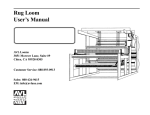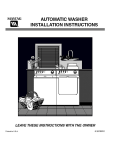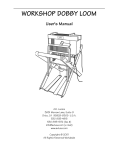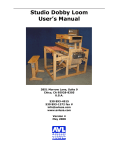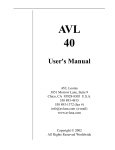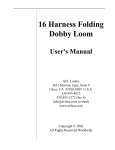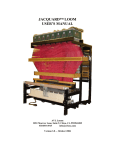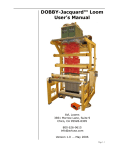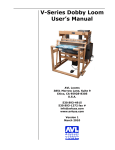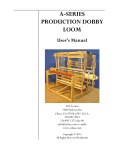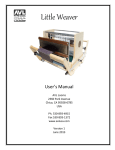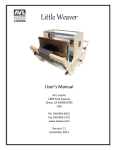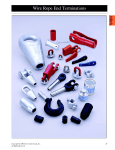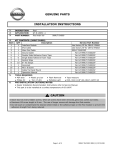Download RUG LOOM USER`S MANUAL
Transcript
RUG LOOM USER'S MANUAL AVL Looms 2360 Park Avenue Chico, CA 95928 Sales: 800 626-9615 [email protected] www.avlusa.com August 2010 TABLE OF CONTENTS Preface Before You Begin 1 1 TOOLS • • • Necessary Tools Helpful Tools Figure 1 - Hardware Identification Chart 2 2 3 HARDWARE • Hardware Hints 4 ASSEMBLY SEQUENCE • • • • • • • • • • • • • • • • • • • • • • • • • • • • • • • • • • • • • • Side Frame Assembly Figure 2 - Right Side Frame Assembly Figure 3 - Left Side Frame Assembly Lower Back Figure 4 - Assembling Lower Left Back Corner Spring Lever Assembly Harness Pulley Support Assembly Square the Frame Lower Front Upper Back Figure 5 Level the Frame Dobby Assembly Beater Assembly Figure 6 Air System Figure 7 - Dobby/Side View Figure 8 Figure 9 - Dobby/Front View Figure 10 - Basic Rug Loom Air System Figure 11 Harnesses Assemblies Figure 12 Cloth Storage Beam Assembly Figure 13 - Cloth Storage Beam Figure 14 - Installing Cloth Beam Cloth Beam Assembly Figure 15 Separation Rollers Figure 16 - Installing Separation Roller Worm Drive Figure 17 - Cloth Storage Crankshaft Assembly Warp Beams Figure 18 - Cloth Beam Handle Brake Cable Assembly Figure 19 Brake Drag Strap Figure 20 - Brake Drag Strap AS-6 AS-7 AS-8 AS-9 AS-10 AS-10 AS-10 AS-11 AS-11 AS-12 AS-12 AS-13 AS-13 AS-13 AS-14 AS-15 AS-15 AS-16 AS-17 AS-19 AS-20 AS-20 AS-22 AS-23 AS-23 AS-23 AS-24 AS-25 AS-26 AS-26 AS-27 AS-27 AS-28 AS-28 AS-29 AS-29 AS-30 AS-30 Page TOC-1 TABLE OF CONTENTS WARPING THE SECTIONAL BEAM TWO OR MORE WARPS Page TOC-2 TABLE OF CONTENTS • • • • Figure 21 - Brake Cable Adjuster Figure 22 Apron Connect the Air System • Compressor • Set Main Air Pressure • System Test • Add Oil AS-31 AS-32 AS-33 AS-33 AS-33 AS-34 AS-34 AS-34 • • • • • • • • • • • • • • • • • • • • • • • Sectional Beam Calculation Extension Cords Feeding the Spool Rack Adjusting the Tension Device Setting a Tracking System Tension Box Tension Box Heddle Installation Instructions Threading the Tension Box Figure 7W - Tension Box Winding the Warp Figure 8W - Winding on the Warp - Half Yard Sectional Beam in Lower Position Figure 9W - Winding on the Warp - One Yard Sectional Beam in Upper Position Adjusting the Size of the Section Figure 10W Figure 11W Counting Turns or Yardage Figure 12W - Attaching Yardage Counter to Tension Box Creating the Cross Sticks in the Treading Cross Routing the Warp Figure 13W - Routing of Warp with Sectional Beam Readjusting the Tension Combining Sectional and Plain Warping W-1 W-3 W-3 W-4 W-4 W-4 W-4 W-5 W-6 W-7 • • • • • • When do you need to tension your warps separately? Setting Two Beams Figure 14W Figure 15W Figure 16W More than Two Warps, Separate Tensioning T-1 T-1 T-2 T-2 T-3 T-4 W-7 W-8 W-8 W-9 W-9 W-10 W-10 W-11 W-11 W-12 W-12 W-12 W-13 ADDENDA Special Instructions for the Automatic Advance and Pressure Rollers • Pressure Rollers A-1 • Pressure Roller Photo A-1 • Control Box A-2 • Control Box Photo 1 A-2 • Control Box Photo 2 A-2 • Automatic Advance A-3 • Automatic Advance Photo 1 A-3 • Automatic Advance Photo 2 A-3 • Direction of the Cloth Diagram A-4 AIR SHUTLE INSTALLATION AND ADJUSTMENTS Installation Figure 1 To Adjust the Beater Height Figure 2 Figure 3 (side view illustration of beater with warp threads) To Install the Air Shuttle Assembly Figure 4A - Left-Side Air Shuttle Box Figure 4B - Right-Side Air Shuttle Box Figure 5 - Air Shuttle Control Box with Front Cover On Figure 6A Figure 6B Figure 7A Figure 7G Figure 8A Figure 8B Figure 8C Figure 9A Figure 9B Figure 9C Figure 9D A1-1 A1-1 A1-1 A1-1 A1-2 A1-3 A1-3 A1-3 A1-3 A1-4 A1-4 A1-5 A1-5 A1-6 A1-6 A1-6 A1-7 A1-7 A1-8 A1-8 Page TOC-3 PREFACE We hope this manual will do three things for you: 1.) Guide you, step by step, through the assembly of your loom — so you’ll be immediately satisfied with its function. 2.) Help you learn about its various systems and components — so you’ll be an even more capable weaver. 3.) Inform you about the care and maintenance of your loom — so you’ll enjoy a lifetime of dependable service. BEFORE YOU BEGIN As we've already said, it’s important that you read this manual and follow its instructions from beginning to end. A quick read through before you actually pick up a tool will give you a good overview of the whole assembly process. The Table of Contents will direct you to each of the major sections. You’ll note that at various places in the text, we’ve inserted a [ ]. This is a reward box. Just add a checkmark as you complete each segment of work. You’ll feel great and it’ll help you stay organized. We know that sometimes you've just got to have a picture, so we've included graphic support where it seems necessary. You may wish to photocopy some of these illustrations and bring them forward with you as you work through the manual. This will save you a good deal of flipping backand-forth in search of that oh-so-helpful diagram. You'll probably find, for example, that you need to refer constantly to the Hardware Identification Chart (Figure 1) and Loom Illustrations (Figures 2 through 4). One last bit of advice: Even the narrower rug looms will require the efforts of two people for many of the assembly operations. Several of the components can be quite heavy, especially in longer lengths. PLEASE TAKE PRECAUTIONS TO PROTECT YOUR BACK, YOUR FINGERS, AND FEET WHEN HANDLING THESE PARTS! Now, read through the manual quickly, then we'll bolt the whole shebang together. Page 1 TOOLS TOOLS You’ll need a few basic hand tools to assembly your loom. We recommend a couple of others that we think will make your job easier. [ ] ratchet and sockets: 7/16”, 1/2”, and 9/16” [ ] standard screwdriver [ ] medium phillips screwdriver [ ] hammer or mallet [ ] 8” or 10” adjustable end wrench [ ] carpenter’s level [ ] framing square [ ] pliers [ ] three wooden blocks or books (approximately 2” thick) [ ] step stool Helpful Tools: Page 2 [ ] power screwdriver with assorted bits [ ] extra ratchet and sockets HARDWARE IDENTIFICATION CHART - FIGURE 1 Necessary Tools: Page 3 HARDWARE If you don't work with hardware, you may find some of the terms a little mystifying. Not to worry, we've provided that easy-to-use identification chart (Figure 1) to help you keep things straight. Hardware Hints: Page 4 A.) If a bolt is a little tight going into a hole, give it a light, friendly tap with a hammer. B.) To start the threads on a nut in a “nut access hole” (Figure 4), you may need to hold the nut in place with the end of a screwdriver or a finger tip. C.) Always have the large "nut access hole" facing toward the inside of the loom unless otherwise specified. D.) Square nuts always go in "nut access holes" and do not take a washer. E.) But, always put a washer under the head of a hex bolt. Any nut that is NOT in an access hole also requires a washer. This will prevent damage to the wood. F.) If you have trouble turning a screw into the wood on your loom, try dressing the threads with a little bar soap. ASSEMBLY SEQUENCE Your first task will be to construct the SIDE FRAMES, left and right, to which you will add the various other loom parts. As you work through the assembly sequence, you will add components in the following order: [ ] lower back [ ] upper back [ ] spring lever support assembly [ ] harness pulley support assembly [ ] cloth beam [ ] square and level [ ] cloth storage beam [ ] worm drive assembly [ ] beater assembly [ ] dobby head [ ] harness cables [ ] harness frames [ ] harness springs [ ] air system [ ] separation roller [ ] warp beam The following illustrations (OV-A through OV-P) are a pictorial overview of the sequence of steps necessary to put you loom together. Please do not use these pictures as a manual. They are for reference purposes only. Page AS-1 ASSEMBLY SEQUENCE Page AS-2 ASSEMBLY SEQUENCE Page AS-3 ASSEMBLY SEQUENCE Page AS-4 ASSEMBLY SEQUENCE Page AS-5 ASSEMBLY SEQUENCE [ ] ASSEMBLY SEQUENCE Side Frame Assembly (tool needed: 9/16” ratchet) You’ll need an area roughly 10’ x 10’ in which to assemble the side frames. If the floor is concrete, you may want to lay a tarp down to protect the lacquer finish on the parts. 1.) Locate Box #1. 2.) Remove the contents. Note that each component is identified by number. These numbers correspond to the Side Frame Assembly diagrams (see Figures 2 and 3). 3.) Arrange the parts at the periphery of your work area. You will find it helpful to separate parts, left and right. Also, orient them so that the large access holes face up. 4.) Check the contents of the hardware bag against its packing list and group similar bolts together. 5.) Each bolt should have been fitted at AVL with a lock washer, a flat washer, and square nut, in that order. 6.) Fit your ratchet with a 9/16” socket and leave it with the hardware. 7.) It’s puzzle time. Beginning with the longest part, 1L, arrange each of the eight left side frame members as shown in Figure 3. 8.) Closely compare Figure 3 against each part. Verify that the holes are lined up. 9.) Use the appropriate bolts, “A” or “B”, to loosely connect each part to its neighbors. 10.) Go back and tighten the bolts (but not so tightly as to crack the wood beneath the flat washers). 11.) Remove the completed left side frame to make room for the right. 12.) Complete the right side frame in the same way. In the next assembly phase, you’ll hang various cross members between the side frames. As you progress, the loom frame will become sturdier and free-standing. Be sure to move the frame to its final position before it becomes too heavy. A 12’ Rug Loom can weigh as much as a half-ton. Moving the steel beams into place is heavy work, especially for the wider looms, and we recommend that you have plenty of help at hand at that point. Page AS-6 Page AS-7 ASSEMBLY SEQUENCE Page AS-8 ASSEMBLY SEQUENCE [ ] Lower Back 1.) Find Box #2 and remove and organize its contents. Note that the cross members have part names instead of numbers. 2.) Locate the cross member hardware pack. Sort and verify its contents. 3.) Move the left side frame into position and lay it on the floor with the access holes facing up. The short, round-topped, vertical member is at the front of the loom. 4.) Bring the Lower Back to the loom and place it on the floor with the access holes facing what will be the front of the loom (see Figure 4). 5.) Use two 3/8” x 4” hex bolt assemblies (bolt/lock washer/flat washer/square nut) to secure the left end of the Lower Back to the rear of the left side frame. Snug the bolts down, but do not tighten. 6.) Repeat for the right side frame. The frame will now stand un-supported (see Figure 5). Page AS-9 ASSEMBLY SEQUENCE [ ] Spring Lever Assembly [ ] 1.) Because each Rug Loom is unique, depending on width and options, the Spring Lever Assembly may be packed in a different box. However, the contents of each box are listed on the outside. Locate the Spring Lever Assembly. In order for the loom to function well, it must be reasonably square and level. We’ll check for squareness first. You may do this with either a carpenter’s square or a 25’ tape measure. 2.) Locate the appropriate mounting holes in the side frames and preposition four 4” hex bolt assemblies. 3.) Bring the Spring Lever Assembly into position. Note: it is correctly oriented if the chains hanging from the levers face the side frames. If they are to the inside of the loom. There should be a label affixed to the assembly that indicates the Top/Front. Square the Frame (tool needed: 25’ tape or carpenter’s square) 1.) Using a Carpenter’s Square: • Check the loom frame at the lower rear corners. Bear against opposing corners to adjust the frame until it comes into square. • Now, go back and firmly tighten all the cross member bolts that you previously left only snug. 4.) Left the assembly into position and slide the bolts home. 2.) Using a Tape Measure: 5.) Add the nuts and snug the bolts. • [ ] Harness Pulley Support Assembly You will use the tape to check the loom’s diagonal measurements. First measure from the inside bottom of the Left Front Vertical, to the outside front of the right Rear Vertical. Record your measurement. 1.) Find the Harness Pulley Support Assembly. It is easily identified by its three sets of black plastic pulleys. • 2.) Bring it to the loom and orient it so that the metal identification plate faces front. One set of pulleys will be offset to the far right side of the loom. Do the same from the Right Front Vertical to the Left Front Vertical. Record and compare the two measurements. When they are equal, the frame will be square. • From opposing corners, bear against the frame as needed to bring the frame to square. 3.) This assembly bolts into the loom from the top. • 4.) Select two 8” hex bolt assemblies and two 10-1/4” or 12-1/4” stud assemblies from your hardware assortment. The studs will have a nylock nut cemented at one end. When you have put the frame square (within 1/8”), go back and tighten all the connecting bolts. [ ] Lower Front (tool needed: 3 blocks or books) 5.) You’ll now need to hoist the assembly into position atop the left and right Top Horizontals. Be very careful of your back; get extra help if you feel you need it. 1.) Bring the Lower Front into position between the free-standing side frames. In this case, orient it so that the access holes face the floor (see Figure 5). 6.) Raise the assembly into place and orient it over the appropriate mounting holes in the Top Horizontals. The ID plate should face forward. 2.) Select four more 3/8” x 4” bolt assemblies and pre-position the bolts in the attachment holes, from the outside of each side frame. 3.) Place blocks under each Front Vertical, left and right. This will raise the front of the loom enough for you to install nuts on the bolt ends where they emerge in the blind access holes. 7.) Page AS-10 ASSEMBLY SEQUENCE Bolt it into place. The long studs insert at the rear holes, the 8” hex bolts in the front. Page AS-11 ASSEMBLY SEQUENCE 4.) 5.) Page AS-12 ASSEMBLY SEQUENCE Place an additional block under the right end of the Lower Front (see Figure 5). Lift the left end of the Lower Front until its bolt holes are opposite those in the side frame. Push the bolts into position and add the square nuts (it’s tight on the fingers, but this will be the only time you’ll be so cramped). Snug, but don’t tighten. [ ] Level the Frame (tool needed: carpenter’s level) 1.) Use the level to check the frame across the center of the Front Harness Pulley Support. 2.) If the bubble is more than slightly beyond the plumb lines, you may need to shim one or more of the verticals. Failure to level the loom now may affect the beater operation level. However, the frame needs to be only reasonably level, not precisely level. You needn’t be overly concerned unless your floor is seriously cattywompus. 6.) Repeat at the right end. 7.) Remove the blocks. You won’t need them again. [ ] Upper Back (you’re quickly becoming a world class loom builder) [ ] Dobby Assembly 1.) Again, pre-position connecting bolt assemblies in the appropriate holes at the upper rear of each side frame. 1.) The Dobby Head is shipped in its own box. Please locate it now. 2.) Unpack the head and set aside the other box constituents (dobby bars, pegs, etc.). Bring the head to the right side of the loom. The cable array is at the top of the unit. 3.) The three attachment bolts are already in place in the head. Remove the hex nuts and washers. 4.) Identify the mounting holes in the Right Side Frame, align the bolts, and push the head into place (see Figure 5). 5.) Add the nuts/washers and firmly tighten the head to the frame. [ ] Beater Assembly 1.) The Beater Assembly is quite heavy and you’ll need help to install it! Note that the mounting brackets are already in place on the side frames. 2.) Bring the Beater Assembly to the front of the loom. 3.) Untape the hardware bag and remove the four short hex bolts with washers. Locate as well the four wooden blocks we provided. Place two bolts and two blocks on the floor to the outside of each side frame. You will use these very soon. 4.) Next, lift the Beater Assembly into position and bolt it into the mounting brackets, using the four hex bolts you’ve pre-positioned at each side of the loom. Leave the end bolts loose for the moment — you still need to adjust the height of the beater. 2.) Bring the Upper Back to the loom and push the bolts into place. 3.) Add square nuts and snug. Page AS-13 ASSEMBLY SEQUENCE 5.) 6.) ASSEMBLY SEQUENCE At each side of the loom, insert two blocks under the slide rods, near the front and rear brackets. These blocks are pre-cut to a particular dimension and will establish the correct height of the beater. Let the Beater Assembly rest on the blocks. Tighten down the four end bolts that connect the slide rods to the support brackets. Remove the blocks. 7.) Move the rubber washers fore and aft, up to the brackets. You should have two washers to the front of the beater and one aft. 8.) Check the travel of the beater. It should move smoothly front-toback, without binding, and should offer very little resistance. If you find that you need to overcome resistance, another adjustment is in order. [ ] Air System You’ve now installed all the major framing members, the Dobby, and the Beater Assembly. It’s a good time to mount the various components that comprise the Air System, before the interior of the loom becomes any more congested. The Rug Loom will support a variety of pneumatic systems in addition to the Basic Air System. If you purchased an Air Advance, Air Shuttle, and/ or an Air Beater, please refer to the addenda provided separately with those systems. Otherwise, you’ll have the Basic Air System. 1.) Please unpack the basic components and lay them out on the floor. They are joined by plastic air tubing and you may think you’ve encountered an octopus, but the whole array should assume shape without much difficulty once it’s out of the box. Note too, that the tube ends are color coded to appropriate fittings, so even if something does come undone, it will be easy enough to reconnect later. 2.) Identify each component against Figure 6. They are individually labeled and there are corresponding labels on the frame. It’s a simple matter of matching item to location. FIGURE 6 Page AS-14 Page AS-15 ASSEMBLY SEQUENCE Page AS-16 ASSEMBLY SEQUENCE 3.) You will install the Air System in the following order: Outside, Right Side Frame (below Dobby): • FRL (Filter/Regulator/Lubricator) • Main Air Valve Page AS-17 ASSEMBLY SEQUENCE Page AS-18 ASSEMBLY SEQUENCE Inside, Right Side Frame: • Manifold (79) • Four-Way Piloted Valve (80) • Shuttle Valves (8’, 10’, 12’ looms only) (81) • Upper Brake Valve (82) • Lower Brake Valve (optional) (83) • Right Lower Brake Cylinder (optional) • Right Upper Brake Cylinder (24) • Left Lower Brake Cylinder (optional and 8’, 10’, 12’ looms) • Left Upper Brake Cylinder (optional and 8’, 10’, 12’ looms) Freestanding: • 4.) The mounting screws for each air component are taped to it. Please attach the individual elements now, proceeding as suggested in the list above. 5.) When all the components are in place, return and tie the tubing into the pre-installed white plastic anchors that you find at various places on the frame. We’ve provided a number of plastic zip ties for this purpose and a few extra anchors which you can use where needed to keep things neat. 6.) Finally, return and visually inspect each connection to be sure that no air lines have come loose. If you find a loose end, simply push it into the appropriately coded connector until you feel it seat. Foot Control (you will have two controls with 8’, 10’, 12’ looms) Page AS-19 ASSEMBLY SEQUENCE Page AS-20 ASSEMBLY SEQUENCE [ ] Harness Assemblies (tool needed: phillips screwdriver) 1.) Locate the Harness Cables, Heddles, Springs, and Harness Frames. 2.) You’ll need to load the heddles onto the harnesses before you hang them. This is most comfortably done on a table. 3.) Lay a harness down and remove the Heddle Support clips from the right or left end, upper and lower. 4.) Withdraw the Heddle Supports a few inches so the ends are free of the harness frame. 5.) Unlay a bundle of heddles opposite the free ends of the supports. 6.) The heddles are strung on cords. Tie each of the cords into the holes at the ends of the Supports. 7.) Transfer an appropriate number of heddles from the bundle to the Heddle Supports. We provide 100 heddles per frame. 8.) Loosen the cords, re-insert the supports, and add the clips. 9.) Repeat for each frame. 10.) Use a phillips screwdriver to remove the two Harness Cable Retainers that sit atop the inboard sets of Harness Pulleys. Or remove the front screw in each, loosen the rear, rotate the retainer out of your way, and place the loose screw back in its original hole until it’s time to re-secure it. This will save you a lost screw later. 11.) Locate and unwrap the Harness Cables. 12.) You will connect each harness cable to a corresponding cable emerging from the top of the Dobby. 13.) To connect a cable, loosen the knurled locking sleeve on the oval connecting link and slide it open. Use the link to connect the Harness Cable to the right most (rear most) Dobby Cable. 14.) The Harness Cable now has two free ends, a long and a short. String the cable over the three corresponding pulleys in line with it. The short leg of the cable will fall over the second pulley, the long over the third pulley (account for “Y” on long looms). 15.) Bring a harness frame to the loom and connect the hanging cable ends into the screweyes in the top of its frame. Note: each harness frame has a top and a bottom. This will be indicated on the frame. If it’s not, just remember that the Harness Cables should hang perpendicularly when connected to a harness. Another check: the screweyes on the tops of the frames are set closest to the center, those on the bottom are further apart. 16.) Note the array of Spring Levers suspended on axles from the Spring Lever Supports. A chain hangs from each lever. Find the two levers that are immediately below the harness frame you just hung. Connect the last link in each chain to the corresponding screw eyes in the bottom of the harness. 17.) Bring the bundle of springs with chains to the loom. Select one of these assemblies. Connect the spring end into the remaining screweye in either of the levers and the chain end into the screweye opposite. You may start left or right, just keep the order consistent as you add each harness assembly. Page AS-21 ASSEMBLY SEQUENCE Page AS-22 ASSEMBLY SEQUENCE 18.) Return now and hang and connect each remaining Harness Frame. [ ] Cloth Storage Beam Assembly 19.) When you’ve installed all the Harness Frames, go back and be sure that the cables are not twisted where they cross the pulleys. Check too, that each cable is properly bedded in its appropriate pulley set. The beams you are about to install are extremely heavy and we advise you to have at least two robust adults on hand for handling them. A third person may be required for beams longer than 8’. 20.) When you are satisfied that all is in order, replace the Harness Pulley Retainers. Tighten them down just enough that the felt strip on the bottom of the retainers is slightly compressed by the pulley below it. The pulley must be able to rotate as the harnesses lift or you will experience undo wear on the cable. Page AS-23 ASSEMBLY SEQUENCE ASSEMBLY SEQUENCE 1.) Locate the Cloth Storage Beam and the large Drive Gear. 2.) Find the separate box of pillow bearings and mounting hardware. 3.) You will first need to mount the Drive Gear to the right axle of the Cloth Storage Beam. 4.) Remove the hardware bag marked Cloth Storage Beam from the box of pillow bearings. 5.) Mount the gear to the axle. First slide the key into the keyway; then slip the gear over the axle and align its slot with the key; push the gear on and flush against the end of the beam; finally, tighten down the set screw. 6.) Bring the beam to the front of the loom and orient it so that the gear is on the right (dobby) side. 7.) On the loom, identify the mounting holes for the pillow blocks. There are two each in the left and right Cloth Storage Supports (see Figure 2, 7R for example). 8.) Slip the pillow blocks onto the beam axles. The grease fitting on the right block (Dobby side) should point to the rear of the loom; that on the left, to the front. You’ll need to lift the beam and insert its left end through the frame. This will give you clearance to bring the right end into position over the mounting holes. Position the pillow blocks over their mounting holes. You’ll note that we have scribed index lines into the frame. Align the blocks with these lines. 9.) Add the bolts and firmly bolt the pillow blocks in place. [ ] Cloth Beam Assembly 2.) Wooden blocks should already be on the axles at both ends. Untape the hardware bags from the beam, remove the four square nuts, and insert the bolts into the holes in the blocks, from the recessed side. 3.) These blocks will rest atop the Front Verticals (see Figure 15). Lift the beam into position now. Engage the bolt ends in the appropriate holes in the verticals. 4.) Add the four nuts and tighten down the block on one end. 5.) Rotate the beam by hand a time or two to settle the remaining block. Tighten. 6.) Rotate the beam again. If it rubs at the ends, loosen one side and make whatever adjustment is warranted. Again, this beam is quite heavy and you’ll need to observe the usual precautions. 1.) Page AS-24 Bring the Cloth Beam to the front of the loom. It is symmetrical, end-to-end. Page AS-25 ASSEMBLY SEQUENCE [ ] Page AS-26 ASSEMBLY SEQUENCE Separation Rollers [ ] Worm Drive You will have one Separation Roller for each Warp Beam. One Warp Beam, one roller. Now you will add the drive mechanism that turns the beam. You will need two 3/4” wrenches to accomplish this. 1.) The Separation Rollers fit into the semicircular pockets in the Rear Verticals. If you plan to use your Warp Beam in the upper position, its Separation Roller will fit the inside pockets. If you will use your Warp Beam in the lower position, place the Separation Roller in the outside pockets. Neither position offers a weaving advantage, but many people find it easier to work from a high beam when warping. 1.) Find the drive mechanism and remove the pivot bolt, pivot block, and wooden spacer. 2.) Fasten the pivot to the loom as shown in (see Figure 17). 3.) Untape the four wood screws you find taped to the Sliding Bracket. Use these to secure the bracket to the inside Front Vertical. If you plan to mount two Warp Beams, you have no decisions to make — the Separation Rollers are exactly alike and you’ll use both. 4.) 2.) Bring a roller to the rear of the loom. Note that the worm lays atop the large drive gear. Move the worm down until the two gears mesh. You may need to pull out on the small spring pin you see at the front of the bracket. Withdraw it enough to free the slide plate so that you can move the worm down. Once done, release the pin into it’s hole. 3.) Untape the hardware bag. In it you will find two flat retainers and four bolt assemblies. 5.) 4.) Remove the hex nut and all but one flat washer on each bolt; insert a bolt with washer into the lower hole in each bracket. Now thread the star handle down tightly. This handle will allow you to lock the worm up and away from the gear if you need to disengage the drive. The pull pin will keep the gears seated when the mechanism is under strain, however, you should also keep the star handle firmly tightened when you are weaving. 5.) Install the two retainers as shown in. 6.) 6.) Place the roller in its pockets and rotate the retainers up. Secure the bolt in each retainer. Connect the Cloth Storage Crank to the front of the drive shaft (see Figure 18). 7.) 7.) Add the upper bolt at each retainer and tighten. Turn the crank in both directions. It should operate smoothly and the gears and beam should turn easily. 8.) Repeat for the second roller (if you have one). Page AS-27 ASSEMBLY SEQUENCE [ ] ASSEMBLY SEQUENCE Warp Beams Last of the heavy lifting. You will have a Sectional Warp Beam, a Plain Warp Beam, or a combination of beams. Regardless, they all mount in the same way. Brake Cable Assembly You will have one brake cable per Warp Beam for 4’ and 6’ Rug Looms; 2 cables for 8’, 10’, and 12’ looms. 1.) Locate a brake cable assembly. It consists of a steel cable and a bracket with mounting hardware. 1.) Bring a Warp Beam to the rear of the loom. 2.) Here again you’ll find a Pillow Block on each axle. 2.) 3.) Untape the hardware, strip the bolts of their washers, and insert them into the mounting holes in the blocks. Bolt one or both assemblies into the right side frame as indicated in (see Figure 19). 3.) Route the brake cable(s) as indicated in (see Figure 21). 4.) Remember, you have a choice of positions for your Warp Beams. You decided once when you installed the Separation Roller(s), but if you want to change your mind now, no one is looking. 4.) Continue to the left side if you have additional brake assemblies. 5.) You will note that the cables can be loosened or tightened by changing the extension of the adjusting bolt in the anchor brackets. These adjustments were preset at AVL and you’ll likely not need to change them now. Over time your cables may stretch and you’ll need to tighten them a bit. 5.) Page AS-28 [ ] Lift the Warp Beam into position and push the bolts through the Verticals. Add the flat washers, lock washers, nuts, then tighten. Page AS-29 ASSEMBLY SEQUENCE [ ] ASSEMBLY SEQUENCE Brake Drag Strap On the opposite side of the Brake Assembly is the Brake Drag Strap. It is used to help keep the beam from twisting. See Figure 20 for details. Page AS-30 Page AS-31 ASSEMBLY SEQUENCE ASSEMBLY SEQUENCE [ ] Apron Your Rug Loom is provided with a heavy canvas Cloth Storage Apron. This provides a convenient way to tie off your warp and conserves warp length, several yards of which would be lost if you tied directly to the Cloth Storage Beam. 1.) Locate and unlay the apron. 2.) Starting about 1/4” from either end of the Cloth Storage Beam, secure the velcro strip of the apron to that on the beam. Take care to keep this interface straight and free of wrinkles. 3.) You have also been provided with several long steel rods. Find one now and slide it through the loops at the other end of the apron. Leave the other Apron Rod aside for now. 4.) Use the Cloth Storage Crank to roll the apron onto the beam. 5.) You will be instructed in the Weaving Section about tying-on to the apron. You are so almost done! It’s a loom! It’s a loom! — and there only a few remaining details to attend. [ ] Connect the Air System Compressor It’s a good time to connect the air delivery line from the compressor to the FRL. Installations differ; for example, the air line from your compressor to your loom may be copper pipe, PVC, or flexible hose. If you are using a rigid tubing, we recommend that you fit at least a few feet of flexible hose between the FRL connection and the main line. This will prevent strain at the connection if the loom moves during weaving. We recommend that you use quick disconnect fittings to connect the air hose to the intake port of the FRL. Your compressor supplier, or any industrial tool or agricultural supply, can help you with this. The fitting should be male with 3/8” NPT threads. It’s helpful if you buy a fitting that already has a sealant applied to its threads. Otherwise, wrap the threads with Teflon tape to avoid a leak. Please do not use pipe dope; it becomes scaly and can contaminate the air components. Page AS-32 Page AS-33 ASSEMBLY SEQUENCE Set Main Air Pressure We pre-set the pressure at the FRL at 75 p.s.i. Please check it now and recalibrate the dial if necessary. Your loom will operate at between 75 and 120 p.s.i., but it’s best to start at the lower setting. System Test This is your first opportunity to test the loom’s function. This test will establish that your air connections are tight, that the harnesses transit smoothly, and that the Warp Beam Brakes are working. We’ve preadjusted the operating speeds and pressures, but you may need to add a few minor tweaks to achieve a particular result. It’s always possible that something was put out of adjustment in handling. 1.) Put the Main Air Valve handle in the OFF position. 2.) Turn on the compressor. 3.) Listen for air leaks in your main air delivery line. 4.) Open the Main Air Valve. Add Oil We provided you with a small bottle of lubricating oil. Consult the manufacturer’s instruction sheet for an explanation of how to add oil at the FRL. Once you’ve added the oil, set the lubrication meter at it lowest value. Your air system requires almost no oil and too much can foul the system. Page AS-34 WARPING THE SECTIONAL BEAM The AVL sectional beam is designed to be warped in sections with the use of a tension box. The yarn travels directly from cones or spools which are mounted on a rack behind the loom, through the tension box, and onto the beam. Throughout the warping process, the tension box automatically keeps a constant and uniform tension on the warp. Not only does this system save time, but it makes it possible to wind on very long warps which would never fit on a warping board or reel. Sectional Beam Calculation First, you must calculate the number of spools or cones of yarn you will need. Each section is wound onto the sectional beam separately, therefore, you’ll need to have one spool or cone for each end in that section (if your section is 2" wide, with sixteen E.P.I., that would be thirty-two spools or cones of yarn). NOTE: It used to be that all sections were 2" wide. On an AVL sectional beam with metal pegs, you can decide to use 1", 2", or any number of inches sections. You can simply add more pegs in the pre-made holes or take them out. To prepare for sectional beam warping, we need to calculate: a) how many spools we need to wind b) how many yards do we need to wind on each spool c) total yardage for the project Page W-1 WARPING THE SECTIONAL BEAM a) NUMBER OF SPOOLS? Sectional beaming requires the use of as many spools loaded with thread per individual section as your planned sett in the reed dictates. To calculate the actual number of spools required, we need to know: - how many EPI are we going to use in the fabric - what SIZE SELECTION will we have to use in the fabric If your warp is set at 24 epi per 1”, you will need 24 spools for a sectional beam with 1” sections or 48 spools for a beam with 2” sectionsl. Therefore we can say: # OF SPOOLS = EPI x SIZE OF THE SECTION b) NUMBER OF YARDS PER SPOOL? To calculate the number of yards per each spool, we need to know: - the LENGTH OF THE WARP - NUMBER OF SECTIONS on the beam We calculate the number of sections by dividing the WIDTH OF THE WARP by the SIZE OF THE SECTION. If the warp width is 40” and we are using 2” sections, our number of sections is 20. All together, we can say: # OF YARDS PER SPOOL = LENGTH OF THE WARP x # OF SECTIONS c) TOTAL YARDAGE? If it is a single color warp or if a color sequence is repeating in each section, the same spools or cones can be used to wind all the sections needed for the warp. TOTAL YARDAGE = # OF SPOOLS x # OF YARDS PER SPOOL Page W-2 WARPING THE SECTIONAL BEAM It is important to make these calculations in advance so that you can purchase your yarn in spools or cones corresponding to the amount of yardage needed on each. Sometimes this is not possible and you will need to wind your own spools from yarn that is in larger packages. For doing this, you will need empty plastic spools, a bobbin winder (preferably electric), and a yardage counter. These items are available from AVL. Extension Cords You might want to make a permanent set of extension cords to use when warping the sectional beam. Extension cords are also called apron cords and have the same function as the apron on the plain beam. They give you "reach" from the warp beam and allow you to weave every possible inch until the end of the warp touches the last shaft you are using. Make them out of a strong non-stretchable linen or cotton cord. You will need to make one extension cord for each section in your sectional beam. For each extension cord, cut a piece of cord. Take the two ends of the cord and knot them together. Measure to make sure that they are long enough to reach all the way to the harnesses. All extension cords should be exactly the same size. When measuring the length of the cords, also check to be sure that when the cords are wound on to the beam, the end of the loop and any knots in the cords fall between the crosspieces of the sectional beam, not on them. A sectional beam is usually not solid. It is a frame that has metal pegs. That way you can keep the warp smooth on the beam without going over the knots of threads. Feeding the Spool Rack Next, place a spool or cone rack about five or six feet behind your loom. Place the spools or cones for the first warp sections on the cone rack. Make sure you put each thread through the metal eye on the spool rack so the threads do not get tangled. When arranging the spools on the spool rack, it doesn't matter whether you go top to bottom or bottom to top, the important thing is to be consistent in vertical columns and to place the spools in the order that the threads are in the warp. Page W-3 WARPING THE SECTIONAL BEAM Adjusting the Tension Device WARPING THE SECTIONAL BEAM b.) Notice there are four twist ties holding the heddles together. Separate the top two. Insert the top bar (of the harness that is up) into the space created by pulling apart the twist ties. Insert the bottom bar (of the harness that is up) into the space created by pulling apart the bottom two twist ties, making certain that the heddles aren’t’ twisted. Now remove the twist ties. c.) Count off fifty heddles and cut the loop at the top between the 50th and the 51st heddle. d.) Now put the four twist ties back on the fifty heddles that were the last to go on the harness. e.) Remove these fifty and reattach the “heddle retainer”. f.) Now push down on the harness that is up, making the other harness come up. Tension Box g.) Remove the heddle retainer. The tension box is an essential warping tool which: h.) Pull apart the top two twist ties and insert the top of the harness (which is up) into the space created. Pull apart the bottom two twist ties and insert the bottom of the harness into the space created. i.) Reattach the heddle retainer. Before winding the sectional beam, make sure to disengage the tension system so that the beam will turn counterclockwise swiftly. To do this, unlock the tension rope from the spring and completely unwrap the plastic cord from around the tension beam drum. Also, remember to remove the weight from the tension arm. Setting a Tracking System On the back of the loom, set a tracking system that will allow the tension box to travel from one section to another. The tension box is fastened to the tracking system with wing nuts. These can be released for the tension box to move. Once centered properly for a particular section, the tension box needs to be tightened again (for each section). a.) Puts threads under tension. b.) Spreads threads to the proper width. c.) Makes thread-by-thread lease. Threading the Tension Box Tension Box Heddle Installation Instructions If this is your first time to use a tension box, you need to install heddles on the harnesses. Your tension box is delivered with one bundle of one hundred heddles. These are held together with twist ties. Leave these on for now. Refer to Figure #7W to familiarize yourself with the tension box and its parts. Push down on one of the harnesses until it stops. This causes the other harness to go up. You will use that later for making a threading cross. Right now we’ll need to use it to help in the assembly of the heddles to the harnesses. a.) Page W-4 Remove the “heddle retainer” of the harness that is up, using a phillips head screwdriver. The best way to thread the tension box is to take one thread from the cone rack and thread it all the way through all the parts of the tension box, then the next thread all the way through. It works best to use the threads from the rack in a vertical order rather than a horizontal order. Now let’s go through the sequence for threading the tension box. First, move the two adjustable tension pegs up above the stationary pegs as shown in Figure #7W or remove them completely. Now sley the thread through the rear (stationary) reed section using a sley hook. Since this reed is eight dents per inch, you will divide the E.P.I. into eight to find out how many ends will be in each dent (with sixteen E.P.I, put two ends in a section). If your E.P.I. does not divide equally by eight, you can either vary the number of ends in each dent (with twenty E.P.I., alternate two and three ends in the dents) or thread the dents a little wider than two inches (with twenty E.P.I., put two ends in each dent; with forty ends, the reed will be sleyed 2 1/2” wide). Page W-5 WARPING THE SECTIONAL BEAM WARPING THE SECTIONAL BEAM With a heavy wool the pegs may only need to be moved half way down, whereas with a fine silk, the pegs may need to be moved all the way down and the yarn wrapped an extra time around one of the stationary pegs to get the proper tension. Once you have adjusted the tension correctly, do not change it during the winding of the beam, as long as you are using the same type of yarn. Once the tension box has been threaded, it is not always necessary to rethread it. If you need to change spools or cones, simply tie the new ends on to the old ends just before the rear stationary reed, then gently pull on the old ends until the new ends have come all the way through the box. Winding the Warp Before you start winding the warp, attach the section of the warp to an extension cord, tie an overhead knot in the warp threads from one section and slip that knot into the opening of the larkshead knot you created in the extension cord. Pull it tight. Next, bring the thread straight through the tension peg section in-between the larger adjustable tension pegs and the smaller stationary pegs or just above the smaller stationary pegs if you have removed the larger ones. Next, thread the end through the two sets of heddles. The first thread goes through the front set of heddles and the next thread goes through the rear set of heddles. Repeat this alternating heddle threading for the rest of the ends. The heddle system will be used later to create the threading cross. Now thread the end through the front pivoting reed. Here you have a choice of using an eight dent or ten dent reed. Pick the one that can be sleyed evenly and as close to the desired section width. If you can not get the exact width of the section, sley your reed slightly wider. This will make it just slightly wider than the space between the pegs. The section will be narrowed down by pivoting the reed. Never sley the reed narrower than the section on the beam. There is no way to expand it. After the tension box is completely threaded, the larger pegs are moved downward to apply tension. The further down they are moved, the more tension will be applied to the yarn. This is an adjustable system as different yarns require more or less tension. Page W-6 Page W-7 WARPING THE SECTIONAL BEAM WARPING THE SECTIONAL BEAM NOTE: If you will be using a flyshuttle and are planning a narrow warp, you need to offset the warp 4” to the right instead of centering it. (Remember, “the right” refers to the right side of the loom as you are seeing it from the weaving position at the loom bench.) This offset will ensure even selvedges. See Figures 8W and 9W for routing the extension cords towards the tension box from the bottom beam position and the top beam position. Extra care to correctly center and adjust the width of each warp section will result in more perfect tension while weaving. Make sure that the threads are going on to the beam in flat layers. If you notice that warp piles up at the pegs, the section of the warp is too wide. If the warp falls down at the pegs, the warp section is too narrow. Adjusting the Size of the Section Line up the tension box approximately behind the section you will be winding. Now wind about one yard onto the beam. As you wind, you will need to fine tune the placement of the tension box along the track. When it is centered properly, tighten down the wing nuts under the tension box. At this point, you can pivot the “pivoting reed section” so that the yarn comes close to, but doesn’t quite touch, either the peg to the left or the peg to the right. Now tighten the wing nut under the pivoting reed. This shouldn’t need to be readjusted until you are using yarn of a very different size. Page W-8 If any of the above is happening, go back and pivot the front reed on the tension box again until you get perfectly flat layers. This is very important, otherwise you will end up having different length threads in one section, since the circumference of the beam within the section is not going to grow evenly. Therefore, you will end up having lots of tension problems. Page W-9 WARPING THE SECTIONAL BEAM WARPING THE SECTIONAL BEAM Counting Turns or Yardage Creating the Cross To determine the length of the warp you are putting on the beam, you need to count either turns, revolutions, or yards. When there is about a half yard left to be wound onto the beam, it is time to make the threading cross. Simply push on the rear heddle frame of the tension box, making half of the threads go up and the other half go down. To count turns, you can do it in your head, but it is more reliable to use a digital or mechanical revolution counter. Counting revolutions even with a digital counter will still give the approximate warp length only, because the circumference of the beam will increase slightly with each rotation. This is called beam build up. To count yards with a yardage counter while warping the sectional beam, you need to place the yardage counter at the front of the tension box. You should use an extra thread for measuring yardage, because if you use one of the threads from your warp section, that particular thread would have a different tension once you start weaving. The extra thread you use for measuring purposes only can be reused for each section. Now slip in an eight inch piece of contrasting thread (called a marking thread) through the opening (called a shed) created between the threads above and the threads below. Locate this marking thread about half way between the tension box and the separation roller. Now push on the front heddle frame, making the other half of the threads go up. Now take one end of your marking thread and bring it through this shed. The two ends of the marking thread should now be together. Tie them in a bow knot. Wind the rest of the first section on, cut the ends, and secure to the wound on thread using a rubber band over the pegs. Continue winding all the sections in the same manner by moving the tension box along its track. Sticks in the Treading Cross When all the winding is complete, remove the rubber bands, unwind a few feet of warp, and slip one lease stick through the path created by the upper portion of each marking tie. Now slip another lease stick through the path created by the lower portion of each marking tie. Secure the lease sticks together, leaving about two inches between them, using masking tape or string through the end holes of the lease sticks. Now bring the lease sticks, with the warp ends, around the separation rollers. Page W-10 Page W-11 WARPING THE SECTIONAL BEAM Routing the Warp Combining Sectional and Plain Warping If you have a beam in the upper position, the warp will be routed under the upper separation roller. If you have a beam in the lower position, the warp will be routed over the lower separation roller (see Figure 13W below). If you are winding a very fine warp, say forty ends to the inch or more, and do not have or do not want to wind a lot of spools or cones, it may be more convenient to wind separate warp sections on a warping board or reel and go from there directly to the sectional beam. If you decide to do this, however, your warp will be limited in length by what will fit on the warping board or reel. If you choose this method, follow these steps: Readjusting the Tension Now tie the lease sticks from the top of the loom so that they are at eye level when you are in your threading position. To keep the warp from slipping forward during the threading process, rewind the tension rope around the pulley and tension drum and clip the rope end to the spring. Remember to replace the tension weight at this time. Page W-12 WARPING THE SECTIONAL BEAM a) Calculate number of threads for each section on your sectional beam. On the warping board or on the warping reel, make “baby warps” for each section on your beam (if you are using a warping board, you will be limited in length). Make crosses at each end: raddle cross on one side and thread-bythread cross on the other. b) Take the warp off the board or reel by taking off the thread-bythread cross first. c) Put the warp threads from a first “baby” warp in the raddle, making sure that threads are spread evenly and that they are creating flat layers when wound on the beam. Put the raddle top on or secure warp threads with rubber bands. Instead of a regular raddle, you can put a mini-raddle in place of the front reed on the tension box. In this case, the tension box is used only for guiding threads into the sections. You do not thread threads in the tension box through the harnesses nor through the back reed and you do not adjust tension with the pegs. d) Attach each baby warp to the extension cords and proceed as in regular sectional beaming procedure. e) Since you are not using the tension box for tension, be sure to keep it taut manually. f) When you come close to the end of the section, take the reed cover off and continue winding the rest of the baby warp. g) Secure that section to the beam and continue to the next one. Page W-13 TWO OR MORE WARPS There will be times when you will want to use more than one warp, which can not be put together on one beam. You will have to put them on separate beams or use some kind of separate tension systems. When Do You Need To Tension Your Warps Separately? When weaving: a) Very different size yarns. b) Yarns with different stretching qualities. c) Different densities. d) Different structures. e) Supplementary warp techniques (because some warp threads do not interlace as often as others). f) A group of special yarns for selvedges and borders. g) Loops, piles, or puckers like seersucker. h) More then one layer with different setts in each layer. i) More than one layer with a different pick count in each layer. Setting Two Beams If you are confident in setting one beam, it is just as easy to set up a loom with two beams. It might take twice as much time and you do need to be more careful not to mix sequences. a) Wind each warp on the beam the same way you would do it if there were only one beam on the loom (plain or sectional). Make a cross and have a pair of lease sticks with a cross in each warp. b) Bring the warp with the lease sticks from the top beam around and under the top separation roller. Page T-1 TWO OR MORE WARPS c) Page T-2 TWO OR MORE WARPS d) Hang both pairs of lease sticks, one a little above the other, so you can see each lease from the threading position. e) Proceed with a threading as if you only had one beam/one cross, following your threading instructions and taking special care of which thread from which pair of lease sticks comes next. Bring the warp with the lease sticks from the bottom beam around and above the bottom separation roller. Page T-3 TWO OR MORE WARPS More Than Two Warps, Separate Tensioning If you have more than two warps to set and not more than two beams, you need to weight/tension your additional warps separately (do the same if you only have one beam and more than one warp to set). Page T-4 a) Make your warp sections on the warping board and take them off the board in a chain, on a kite stick, or just in a plastic bag. Make sure that each bundle is not too thick. You will know when you need to divide each bundle if you feel that all the threads are not being tensioned evenly. b) The weight needs to have a strong loop of string on it so the warp bundles can be slip knotted into it. This makes it easy to undo the slip knot and move the weight when it climbs up to the back beam and must be let down again. c) The weight also needs to be adjustable. Plastic bottles with handles filled with water are perfect. You can also use fishing weights, washers, nuts, bolts ... They are not as easily adjustable like water bottles, but take less space. The lower to the floor you can hang them, the less often you need to reposition them. ADDENDA Special Instructions for the Automatic Advance and Pressure Rollers. PRESSURE ROLLERS ... an important part of the Cloth Take-Up Mechanism Follow these instructions to assemble the Side Frames, tie them together with the cross-members, and then you'll be ready to put on the Pressure Rollers. The Pressure Rollers have been clearly labeled Back and Front (referring to the front of the loom). They have been placed in their crate in their proper position. It is critical that the Pressure Rollers go on in the correct orientation with Front in the front and Back in the back. They won’t fit any other way and the other gears, particularly for the Automatic Advance and Cloth Beam, won’t fit if they are incorrectly situated. PRESSURE ROLLERS MOUNTED ON THE LOOM WITH GEARS ENGAGED Page A-1 ADDENDA ADDENDA CONTROL BOX AUTOMATIC ADVANCE After mounting the Dobby (see page 22), you will Mount the Control Box. It is attached to the Right Side Frame by four bolts. The Automatic Advance instructions in the User’s Manual are accurate (see page 24 for detail). Except you have an AUTOMATIC ADVANCE mechanism on BOTH sides of the loom. PHOTOS: (right) CONTROL BOX MOUNTS WITH THE FOUR CIRCLED BOLTS (note: the FRL in the lower left corner) (below) CONTROL BOX SEEN ON THE LEFT SIDE OF THE LOOM Note that the Control Box encompasses the FRL (as seen on page 23). The box comes pre-assembled, so there shouldn’t be any problem mounting it. Continue connecting the Air System as described in the Manual. Page A-2 Page A-3 ADDENDA When connecting the Automatic Advance, make sure you: 1.) Check the mechanisms (left and right). They need to be working together, not in opposition to one another. Double check, it’s not as easy as it sounds. 2.) Look at the Automatic Advance mechanisms before mounting them. They have been pre-assembled by AVL, but get oriented first (use the photos). 3.) Don’t force anything. The gears should slide together readily. If they don’t, then contact AVL immediately. DIRECTION OF CLOTH Cloth Beam Pressure Rollers Cloth Take-Up Lower Horizontal Page A-4 AIR SHUTTLE INSTATLLATION AND ADJUSTMENTS Congratulations on your purchase of the AVL Air Shuttle system. We hope they provide you years of productive weaving. INSTALLATION Installation of the Air Shuttle occurs after the installation and proper adjustment of the Beater as the Beater height adjustment affects the Air Shuttle adjustment. Before proceeding with the Air Shuttle installation, please install the Beater as described in the Rug Loom Manual provided with your loom. Ensure that the Beater height is adjusted to allow a taut warp thread to rest lightly upon the Beater Race. Adjustment to the Beater height is accomplished by loosening bolts holding the Beater Slide Rods to the slotted Beater Support Brackets as shown in Figures 1 and 2. Beater Beater Race Beater Slide Rod (moving the rod up/down adjusts the Beater height) Height Adjustment Bolts for the Beater FIGURE 1 To Adjust the Beater Height 1.) Thread and fix with tape three warp threads from the bottom of the Warp Beam through the lowest heddle, then through the Reed to the top of the Breast Beam. One warp thread should be located in the center of the beams (approximate center is fine). The other two warp threads should be located on either side near the maximum weaving width of the beams (again, approximate locations are fine). Note whether each warp thread is touching the Beater Race. FIGURE 2 Page A1-1 AIR SHUTTLE INSTATLLATION AND ADJUSTMENTS Proper Warp Beater Height Beater Too High Beater Too Low In adjusting the Beater height, you will be setting the three warp threads so that they are resting upon the Beater Race. If the warp threads are above the Beater Race, they may catch and break on the Shuttle during weaving. If the warp threads are resting too heavily on the Beater Race, it may affect your fabric quality and, in extreme cases, also catch and break on the Shuttle during weaving (see Figure 3). AIR SHUTTLE INSTATLLATION AND ADJUSTMENTS To Install the Air Shuttle The Air Shuttle system contains three major components: the left and right Shuttle Boxes (Figures 4A and 4B) and the Control Box (Figure 5). Assembly FRONT OF THE LOOM ------> Warp Thread Beater FIGURE 3 (Side View Illustration of Beater with Warp Threads) 2.) Loosen both bolts of one Beater Slide Rod. Then, lift or lower the Beater Slide Rod until the warp thread on this side of the loom is touching the Beater Race. Tighten both Beater Slide Rod bolts. Repeat on the other side of the loom. 3.) Verify that the three warp threads now rest on the Beater Race. If they do not, repeat Step 2. FIGURE 4A - Left-Side Air Shuttle Box FIGURE 4B - Right-Side Air Shuttle Box FIGURE 5 - Air Shuttle Control Box with front cover on Page A1-2 Page A1-3 AIR SHUTTLE INSTATLLATION AND ADJUSTMENTS AIR SHUTTLE INSTATLLATION AND ADJUSTMENTS It also contains several minor components, including pneumatics, firing switch, and beater location sensor. 1.) 2.) Attach the pneumatic hoses within the Control Box. The hoses will either be color or numerically coded to guide you. Now is a good time to verify to which Air Shuttle Picker Cylinder each of the pneumatic hoses will be attached. (The longer set of hoses will attach to the left side Air Shuttle Picker Cylinder.) Route the hoses to their approximate locations on either side of the Beater. The left side will be routed along the Spring Lever Support Crossmember. 3.) Attach the Firing Switch to the top, center of the Beater using the wood screws provided (Figure 7A). Route the Firing Switch wiring along the top of the Beater using the wire ties provided. Attach the Wiring Mounting Bracket (Figure 7B). Continue routing the wiring to the rear, then down the right Vertical member to the rear of the Control Box using the wire ties to secure the wire to the pre-mounted wire tie mounts. Route the wiring through the lower rear access hold and connect the wiring in the Control Box using the color/numerical coded wiring. Attach the Air Shuttle Control Box to the right side of the loom using the bolts and UHMW spacers provided (see Figures 6A and 6B). three mounting bolts for the Air Shuttle Control Box FIGURE 6A FIGURE 7A two UHMW spacers The bolts go through the spacers into the right vertical side frame member of the loom. FIGURE 6B FIGURE 7B Page A1-4 Page A1-5 AIR SHUTTLE INSTATLLATION AND ADJUSTMENTS AIR SHUTTLE INSTATLLATION AND ADJUSTMENTS 4.) Attach the left-side Air Shuttle Box to the left side of the loom using the hardware (three bolts and washers) provided. The bolts should be left hand-tight as you will shortly be adjusting the boxes (see Figures 8A and 8B). 5.) Attach the Picker Cylinder to the left side of the loom using the hardware (four bolts and washers) and the UHMW spacer provided (see Figures 8A and 8C). Attach the color or numerically coded pneumatic hoses to the Picker Cylinder. Mount the pneumatic hoses to the wire tie mounts attached to the Lower Harness Support Crossmember with the wire ties provided. 7.) With the Beater at the home position (closest to the harnesses), tilt and maneuver the Air Shuttle Box until the shuttle cavity is positioned slightly above and at an angle that is the same as or slightly greater than the tilt of the Beater Race (see Figure 9A). Hint: The Beater Race is slightly tilted towards the Harnesses to help keep the shuttle on the Beater Race as it flies across. Tighten the mounting bolts that hold the Air Shuttle Box in this position. Beater Race Shuttle Shelf 6.) If not already attached, attach the Picker Arm to the Picker Cylinder, Pivot Point, and the Picker with the hardware provided (see Figure 8A). Mounting holes/bolts Picker (green) Picker Arm Picker Pivot Point FIGURE 9A 8.) For the next step, you will need a straightedge of one-to-two feet long. Slide the straight-edge along the beater until it reaches the Shuttle Shelf in the Air Shuttle Box. There should be a very slight (1/16 inch or less) height difference with the Beater Race being slightly lower causing the straight edge to catch as it is slid up and onto the Shuttle Shelf. This height adjustment is approximate and need not be exact (see Figure 9B). FIGURE 8A Straight Edge Picker Cylinder, mounting block and hardware Beater Race FIGURE 8B Shuttle Shelf FIGURE 9B FIGURE 8C Page A1-6 Page A1-7 AIR SHUTTLE INSTATLLATION AND ADJUSTMENTS Perform fine adjustments on the height of the Shuttle Shelf using the stop collars on the outside support rod of the Air Shuttle Box (see Figure 9C). Collars Support Rod FIGURE 9C Loosen the screws on the top and bottom collets and raise or lower the Shuttle Shelf as required. When done correctly, a slight gap can be seen between the straight edge and the Beater Race when resting the straight edge across the Shuttle Shelf/Beater Race (see Figure 9D). Re-tighten the collar screws once the fine adjustment is complete. Gap between the Straight Edge and the Beater Race FIGURE 9D 9.) Page A1-8 Repeat Steps 4 through 8 for the right side Air Shuttle Box.










































